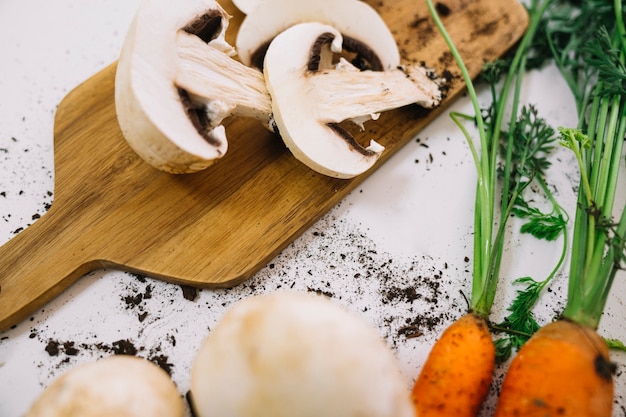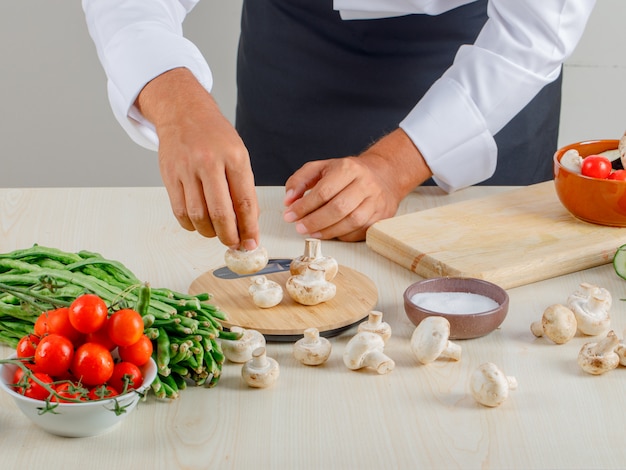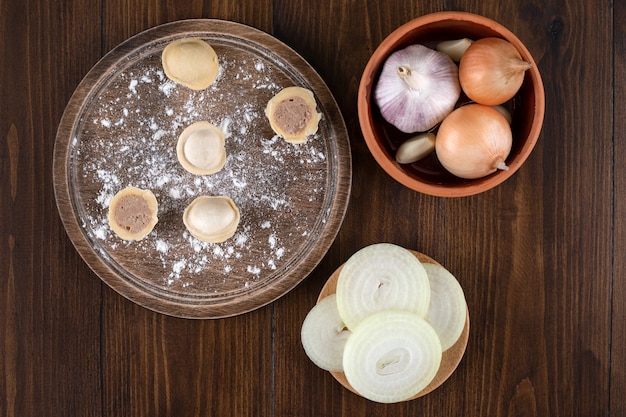Garlic. Just saying the word conjures up images of sizzling pans, aromatic dishes, and the warmth of home-cooked meals. It's the secret ingredient that elevates everything from humble pasta sauces to decadent roasted vegetables. But, like any good secret, you need to know how to handle it. So grab a notepad, get ready for a garlic adventure, and let's dive into everything from the basics to the most ingenious tricks.
(Part 1) Getting to Know Your Garlic: The Foundation of Flavor

I've been cooking for years, and I've learned a thing or two about garlic. But the first thing you need to know is that not all garlic is created equal. There are different varieties, each with its own unique flavour profile. For instance, the pungent, robust flavour of Italian garlic is perfect for pasta sauces, while the more subtle sweetness of Spanish garlic shines in roasted dishes. And let's not forget about the beautiful purple garlic, with its milder flavour, perfect for adding a touch of elegance to salads.
Choosing the Right Garlic: A Fresh Start
So how do you pick the perfect garlic? You want to look for firm, plump bulbs with a dry, papery skin. Avoid bulbs that are soft, mushy, or have any signs of sprouting. These are signs that the garlic is old and might not have the best flavour. As a rule of thumb, fresher garlic is always better. Think of it this way: you wouldn't use stale bread for toast, would you? Same goes for garlic!
Storing Garlic Like a Pro: Keeping it Fresh for Longer
Now, here's a tip that's saved me countless times. Never refrigerate garlic! It actually degrades the flavour. Instead, store it in a cool, dark, and well-ventilated place. The ideal spot is a pantry or a drawer, where it can breathe. And if you're lucky enough to have a cool, dry basement, that's even better. Imagine, keeping your garlic fresh for months!
Peeling Garlic: Techniques and Tools for Effortless Prep
Now, onto the peeling. This is where things can get a bit messy, but I've got a few tricks up my sleeve. The classic method is to smash the garlic with the flat side of a knife, then peel away the skin. It's simple, but it can be a bit messy. However, for larger quantities, I like to use a garlic press. These handy tools crush and mince the garlic all in one go, making life a lot easier. And let's face it, who doesn't love a gadget that makes cooking faster and easier?
But, for a truly elegant approach, try this: chop off the top of the garlic bulb, then simply squeeze the cloves out of the skin. It's surprisingly effective, and it feels so much more sophisticated than smashing it with a knife. Plus, it helps you avoid those pesky little garlic skin bits that sometimes find their way into your dish.
(Part 2) Mastering Garlic Techniques: Bringing Out the Best in Your Ingredient

Okay, you've got your garlic, you've peeled it, now it's time to cook! But before you just toss it into the pan, there are a few things to consider.
Mincing Garlic: Achieving the Right Texture for the Right Dish
Minced garlic is a staple in most kitchens. You can use a knife, a garlic press, or even a microplane grater. I find that the best way to mince garlic is with a sharp knife, using a rocking motion to chop it finely. It takes a bit of practice, but the results are worth it. A garlic press is great for larger quantities, but it can sometimes crush the garlic too much, resulting in a paste-like texture. This can be fine for certain dishes, but if you want a more delicate flavour, a knife is the way to go. The microplane grater produces a fine, almost powdery garlic, perfect for dishes where you want a subtle flavour, like a light sauce or a creamy soup.
Sautéing Garlic: Unlocking the Aromas
Sautéing garlic is a crucial technique that unlocks its full flavour potential. Start with a hot pan and a good quality oil. Olive oil is my go-to, but you can also use vegetable oil or even butter. Once the oil is shimmering, add the garlic and cook for about 30 seconds, stirring constantly. The garlic should become fragrant and lightly golden, but don't overcook it, as it will turn bitter. This is the point where the kitchen fills with that heavenly garlic aroma that makes you feel all warm and fuzzy inside.
Roasting Garlic: Transforming Garlic into Sweetness
If you're looking for a sweeter, milder flavour, try roasting garlic. Simply cut the top off a whole bulb and drizzle it with olive oil. Wrap it in foil and roast in the oven at 400°F (200°C) for about 45 minutes. The roasted cloves can be used in dips, spreads, or even as a topping for grilled meats. It's like magic - roasting mellows out the garlic's sharpness and brings out a beautiful, sweet flavour that's absolutely irresistible.
(Part 3) Garlic Recipes: From Classic to Creative

Alright, now that you've got the basics down, let's dive into some delicious recipes. These are some of my personal favourites, and I promise, they're all easy to make and guaranteed to impress.
Classic Garlic Bread: A Timeless Favourite
Who doesn't love a good garlic bread? It's the perfect side dish for any pasta or pizza, and it's so easy to make. Simply spread softened butter onto crusty bread slices, sprinkle with minced garlic, and bake in the oven until golden brown. You can also add herbs like parsley or oregano for extra flavour. I like to add a sprinkle of grated Parmesan cheese for a bit of extra cheesy goodness. It's the ultimate comfort food, and it always goes down a treat.
Garlic and Herb Pasta Sauce: A Simple, Flavorful Delight
This pasta sauce is a staple in my kitchen. It's incredibly versatile and can be customized with your favourite herbs and vegetables. Simply sauté minced garlic with olive oil, add canned tomatoes, and simmer until thickened. Season with salt, pepper, and your favourite herbs. I like to add a pinch of red pepper flakes for a touch of heat. You can also add chopped onions, mushrooms, or even spinach for a more complex flavour. It's the perfect blank canvas for your culinary creativity.
Roasted Garlic and Parmesan Dip: A Creamy Indulgence
This dip is a real crowd-pleaser. It's creamy, cheesy, and packed with flavour. Simply roast a whole head of garlic, then mash it together with cream cheese, Parmesan cheese, and a dash of garlic powder. You can also add a touch of sour cream or Greek yogurt for a lighter, tangier dip. Serve with crusty bread or vegetables for dipping. It's the perfect party appetizer, and it's sure to disappear in a flash.
(Part 4) The Power of Garlic: Beyond the Flavor, a Healthful Ally
We all know garlic is delicious, but did you know it's also packed with health benefits? It's a natural antibiotic, antiviral, and antifungal, making it a powerful weapon against colds and flu. And let's not forget about its ability to boost your immune system. Garlic is also a great source of antioxidants and may even help lower blood pressure. So, enjoy it guilt-free!
(Part 5) Garlic Myths: Separating Fact from Fiction
Okay, time to address the elephant in the room: garlic breath. It's a real thing, folks! The pungent smell is caused by compounds released when garlic is crushed or cut. But fear not! There are ways to combat it. Eating parsley, drinking milk, or chewing on coffee beans can help neutralize the odour. And remember, a little garlic goes a long way, so don't overdo it!
(Part 6) Experimenting with Garlic: Beyond the Basics
Now, let's get a little adventurous. Garlic isn't just for savoury dishes. It can also add a unique flavour to desserts and cocktails. Try adding a pinch of roasted garlic to your next cake recipe, or use a garlic-infused syrup in a classic mojito. Imagine the surprise on your guests' faces when they taste a hint of garlic in their dessert! The possibilities are endless!
(Part 7) Garlic Around the World: A Global culinary journey
Garlic is a global ingredient, beloved in cuisines worldwide. From the vibrant dishes of Italy to the aromatic curries of India, garlic plays a key role in shaping the world's culinary landscape. It's a common thread that connects cuisines from different cultures. Experiment with different garlic varieties and cooking techniques to discover the vast range of flavours this versatile ingredient has to offer. You'll be surprised at the diverse ways garlic is used around the world.
(Part 8) The Art of Garlic: Bringing Your Dishes to Life
Cooking with garlic is an art form. It requires a delicate balance of flavour, texture, and timing. By mastering the fundamentals and experimenting with different techniques, you can elevate your dishes to new heights. Remember, a pinch of garlic can transform a simple meal into a culinary masterpiece. So, get creative, explore new flavours, and let garlic be your guide.
(Part 9) FAQs: Addressing Your Garlic Queries
Let's address some common questions about garlic.
1. How long can garlic be stored?
Garlic can be stored for several months in a cool, dark place. However, the flavour will start to deteriorate after about 4-6 months. If you notice that the garlic is starting to sprout or soften, it's time to use it up or discard it. You don't want to use old garlic, as it won't have the same fresh flavour.
2. What is the best way to prevent garlic breath?
While garlic breath is a natural side effect of consuming garlic, there are a few things you can do to minimize it. Eating parsley, drinking milk, or chewing on coffee beans can help neutralize the odour. It's also helpful to brush your teeth and use mouthwash after eating garlic. But even if you do get garlic breath, don't let it stop you from enjoying this wonderful ingredient.
3. Can garlic be used in desserts?
Absolutely! Roasted garlic adds a unique sweetness and depth of flavour to desserts. It's a surprisingly delicious addition to cakes, cookies, or even ice cream. You can also infuse garlic into syrups for cocktails or desserts. Just remember to use it sparingly, as you don't want to overpower the sweetness of your dessert.
4. What are the health benefits of garlic?
Garlic is a powerhouse of nutrients and offers numerous health benefits. It's a natural antibiotic, antiviral, and antifungal, making it an effective remedy for colds and flu. Garlic is also a good source of antioxidants and may help lower blood pressure. So, not only is garlic delicious, it's good for you too!
5. How do I know if garlic is bad?
Garlic that is bad will have a soft, mushy texture and a strong, pungent odour. The cloves may also be discoloured or have sprouted. If you notice any of these signs, it's best to discard the garlic. Remember, you want to use garlic that's fresh and flavorful for the best results in your cooking.
Well, there you have it – your ultimate guide to cooking garlic. Now, go forth and conquer the culinary world! Remember, garlic is your friend. It's a simple ingredient that can transform your dishes into something extraordinary. So get cooking, experiment, and let your garlic adventures begin!
Everyone is watching

Corn on the Cob: The Ultimate Guide to Perfectly Cooked Ears
Healthy MealsAh, corn on the cob. Just the name evokes images of sunny days, barbecues, and that sweet, juicy flavour that ...

Scallops: The Ultimate Guide to Perfect Cooking
Healthy MealsAh, scallops. Those delicate, sweet, and utterly delicious morsels of the sea. They hold a special place in my...

Spaghetti Squash: The Ultimate Guide to Cooking and Serving
Healthy MealsRemember that time you saw spaghetti squash at the supermarket, looking all bumpy and strange, and thought, "W...

Salmon Cooking Times: Perfect Guide for Every Recipe
Healthy MealsLet me tell you, cooking salmon is an art form. It's all about getting that perfect balance: juicy and tender,...

Ham Cooking Time: How Long to Bake, Smoke, or Boil a Delicious Ham
Healthy MealsAh, ham. It's a classic, isn't it? A real crowd-pleaser, especially around holidays. And when done right, it'...
